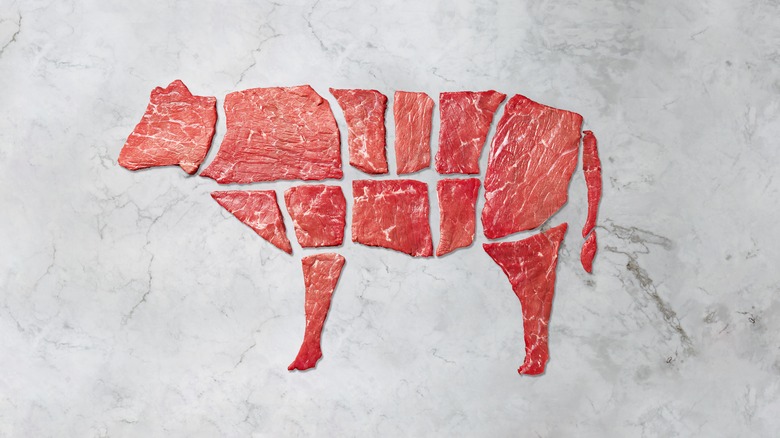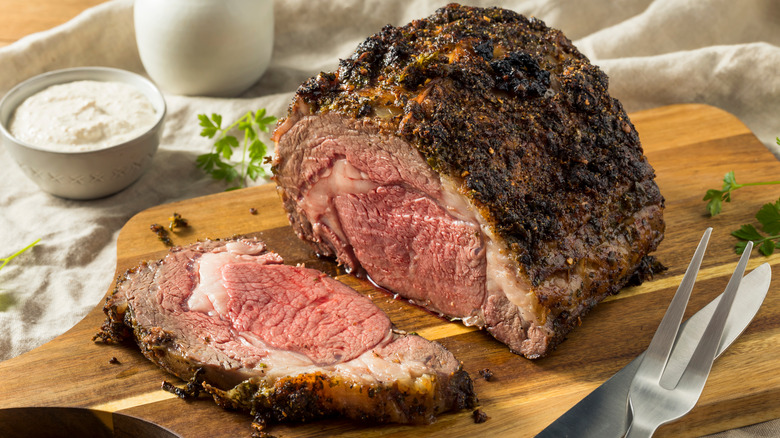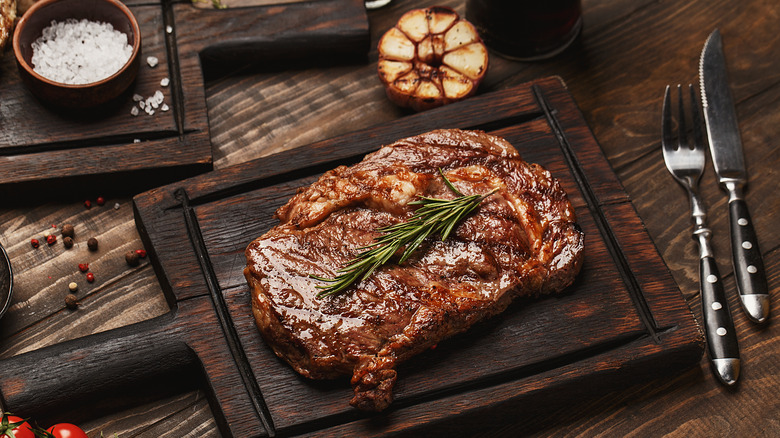Prime Rib Vs. Ribeye: The Preparation Difference You Should Know About
Everybody may have their own opinion on which cut of beef is superior. However, two cuts that frequently top people's lists are the prime rib and ribeye. As their somewhat similar names suggest, these cuts are closely related, but when it comes to preparing them, they could not be more different.
Both prime rib and ribeye come from a cow's rib section, which is known as a primal cut. As Barbecue FAQ explains, the first step in butchering a cow is dividing it into eight primal cuts, which can then be further broken down into hundreds of different 'sub-primal' cuts. The primal cuts are rib, chuck, brisket, shank, flank, loin, round, and short plate. Oddly enough, the rib primal cut does not include all of the cow's ribs. Per Food Network, cows have 13 pairs of ribs. The first five are part of the chuck section and the 13th is part of the loin, and prime rib and ribeye are found in ribs 6-12.
How to prepare prime rib
Prime rib is a roast, as opposed to a steak, which is a smaller cut designed for individual eating, while a roast serves several people. The Pioneer Woman explains that even if you order a prime rib 'steak' at a restaurant, what you're really getting is a single slice of a larger roast, known as a 'standing rib roast.' According to Food Network, a standing rib roast can weigh up to 25 pounds, so butchers usually divide it into two smaller segments called the first cut and second cut. The first cut is also known as the 'small end' or 'loin end' because it comes from the hindquarters near the loin. The second cut, also called the 'large end,' comes from the front of the cow near the chuck.
A common misconception about prime rib is that its name refers to the USDA system of meat grading. The U.S. Department of Agriculture classifies beef as 'select,' 'choice,' or 'prime,' based on the degree of marbling (intramuscular fat). Prime beef has the highest level of marbling, meaning it is more flavorful and tender. However, Food Network explains that the name 'prime rib' has nothing to do with this grading system, so ask your butcher for clarification. As with all roasts, prime rib should be cooked low and slow in the oven.
How to prepare ribeye
The ribeye is actually part of the standing rib roast, but unlike prime rib, it is cooked in individual steaks. Food Network explains that ribeye specifically comes from the first cut of the prime rib, which is technically defined as ribs 10-12. The principle behind cooking ribeye steaks is exactly the opposite of prime rib roasts: high and fast rather than low and slow. The Pioneer Woman recommends searing your steaks over direct heat using a grill or a cast-iron pan. With the right combination of heat and timing, the ribeye should turn out tender and juicy, much like a prime rib, but with the added texture of a crisp, charred crust.
Both prime ribs and ribeyes may benefit from dry-aging prior to being cooked. This process serves two purposes, according to Steak School. The first is to tenderize the meat, and the second is to develop a more complex flavor. You can dry-age beef at home, though it takes space, time, and special equipment, which is why you may prefer to let a butcher handle the task, per Steak School. The Pioneer Woman notes that prime rib and ribeye steaks are both among the most expensive cuts of beef, but prime rib tends to cost more simply based on the fact that it's larger. Unless you're planning to feed a crowd, individual steaks may be the better choice.


